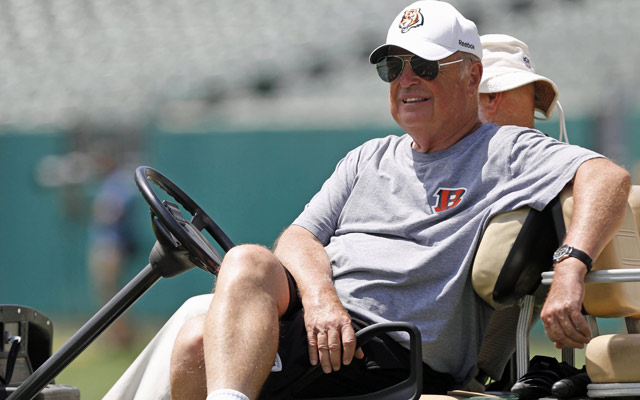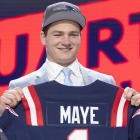The Cincinnati Bengals earned a reputation as a cheap, poorly run mom and pop operation after Mike Brown assumed ownership duties in 1991 upon the death of his legendary father, Paul Brown. The franchise became the NFL’s biggest example of futility as the team didn’t have a winning record in the first 14 years Brown was in control.
Nepotism isn’t unusual in the NFL. It just seemed more magnified in Cincinnati because most key executive positions were held by family members.
Brown had operated as the de facto general manager during most of his reign. The scouting department had been woefully undermanned compared to other NFL franchises. Brown raised the ire of Bengals faithful by taking an annual bonus of at least $1 million from 1991 to 2009 as compensation for general manager duties.
A low point may have been after the 2010 season. Quarterback Carson Palmer, the face of the franchise, retired rather than continue playing for the Bengals because Brown wouldn’t accommodate his trade request. Brown relented when the Oakland Raiders gave up a 2012 first-round pick and 2013 second-round pick for Palmer as the trade deadline approached in 2011.
Since then, Brown has voluntarily relinquished some of his control. Brown is relying more heavily on head coach Marvin Lewis, who is the NFL’s second longest tenured head coach at 13 years, his coaching staff and Director of Player Personnel Duke Tobin for personnel decisions. Executive vice president Katie Blackburn, his daughter, handles player contracts and manages the salary cap. The scouting department has also been upgraded.
Reputations are sometimes hard to overcome. The Bengals are one of four teams to reach the playoffs every season since the lockout ended in 2011. The others are the Denver Broncos, Green Bay Packers and New England Patriots. Cincinnati’s 4-0 start is its first in a decade.
Here’s a look at why the old perceptions of the Bengals are no longer reality.
It's all about the NFL Draft

The Bengals are built primarily with homegrown talent as 47 of the 58 players on the current roster, which includes players on reserve lists, were either drafted or originally signed as undrafted free agents by Cincinnati. Only the Green Bay Packers at 91.4 percent have a higher percentage of homegrown talent than the Cincinnati’s 81 percent.
Of those 47 homegrown players 42 were draft picks. This ties the Bengals with the Packers for the most originally drafted players on an NFL roster. Offensive and defensive starters account for 20 of the 22 of the homegrown lot.
The Bengals are having success with early picks of the NFL Draft. Seven of the 11 offensive starters were selected by the team in the first two rounds. Most notably, wide receiver A.J. Green, who was the fourth overall pick in 2011, has earned Pro Bowl honors in each year of his NFL career. Equally important, Cincinnati has been adept at finding talent later in the draft. Eight starters were drafted in the fourth round or later, including two-time All-Pro defensive tackle Geno Atkins. He was a 2010 fourth-round pick.
Cincinnati’s talent is comparable with the Las Vegas oddsmakers’ preseason Super Bowl favorites (Denver Broncos, Green Bay Packers, Indianapolis Colts, New England Patriots and Seattle Seahawks) according to Pro Football Focus (PFF). The following chart looks at the number of above average players, as determined by PFF, on the rosters of the contending teams and the Bengals.
| Above-average players by category | ||||
| Team | Good | High Quality | Elite | Total |
| Broncos | 7 | 7 | 3 | 17 |
| Patriots | 10 | 2 | 3 | 15 |
| Bengals | 9 | 4 | 2 | 15 |
| Packers | 4 | 6 | 4 | 14 |
| Seahawks | 3 | 6 | 4 | 13 |
| Colts | 5 | 3 | 1 | 9 |
| Data provided by Pro Football Focus | ||||
Cincinnati is strong in trenches. Only one starting lineman on each side of the ball didn’t rate as above average. Left tackle Andrew Whitworth is considered elite.
Quarterback Andy Dalton, who is elevating his level of play to start the season, isn’t reflected in the table since the ratings were done in the offseason. He was regarded as average.
Duke Tobin is the unsung hero in Cincinnati’s resurgence. He has been essentially operating as the general manager without the actual title since Mike Brown decided to take a step back with the organization.
Player contracts and salary cap philosophy

The Bengals are among the NFL’s most proactive teams in signing core players to contract extensions in advance of the expiration of rookie contracts. These core players have included Atkins, linebacker Vontaze Burfict, Dalton, defensive end Carlos Dunlap, Green and cornerback Leon Hall in recent years.
The extensions are designed to be beneficial to both the player and the team. The player receives a level of security earlier than usual without incurring the risk of injury and poor performance associated with playing out the remainder of his rookie contract or experiencing the uncertainty of the free-agent market. The player also runs the risk of being underpaid if he outperforms his new contract or the salary landscape at his position changes.
The Bengals sign veteran players long term using the most favorable contract structure in the NFL. The only guaranteed money in Cincinnati contracts consists of a signing bonus and a roster bonus payable within a few days of signing. There is also an unguaranteed early roster bonus in the second contract year, typically before the fifth day of the league year (mid March). These roster bonuses are supposed to be substitutes for additional contact guarantees.
The Pittsburgh Steelers and Packers use the same approach to structuring contracts but with slightly more flexibility. Green Bay made structural concessions with Aaron Rodgers by giving him roster bonus guarantees in his second and third contract years. He is the only player on the Packers with a veteran deal that has guarantees after the first contract year. Ben Roethlisberger’s two extensions contain injury guarantees while Pittsburgh’s other veteran deals don’t have any salary guarantees.
The Bengals didn’t deviate from their preferred contract structure with Green, their best player. His recent four-year, $60 million extension makes him the NFL’s second highest paid wide receiver (by average yearly salary) behind Calvin Johnson. Although the $15 million signing bonus is Green’s only guaranteed money in the deal, his cash flow (through 2017) is better than Demaryius Thomas, Julio Jones and Dez Bryant’s, who also recently signed lucrative contracts.
The Bengals weren’t afraid to establish a second or middle salary tier for starting quarterbacks in 2014 with Dalton. He received a six-year, $96 million extension containing $18 million of base salary escalators tied to playoff performance that can increase the overall value to $114 million. Dalton has a team high $17 million in guarantees.
Cincinnati’s lack of contract guarantees shouldn’t be confused with frugality. The current Collective Bargaining Agreement (CBA) requires teams to spend 89 percent of the salary cap in cash over four year periods of 2013 through 2016 and 2017 through 2020. The Bengals were fourth in spending during 2013 at slightly under $141 million according to NFLPA data. In spending to date during the current four year period, the Bengals are seventh in the NFL with approximately $416.5 million.
Cincinnati’s contract approach protects against getting into a precarious salary cap position. The minimal guaranteed money allows the Bengals to get out of contracts without adverse cap consequences if a mistake is made on an extension or a player starts to decline in the latter stages of the deal.
Unlike the Steelers, who have a similar method in structuring deals, the Bengals are more mindful of the long-term implications with salary cap management. Cincinnati has avoided pushing the envelope with the salary cap through contract restructures. A player will convert some portion of his base salary or roster bonus (without reducing salary) into signing bonus because it can be prorated or spread out evenly over the life of a contract (most other salary components usually can’t be prorated) for a maximum of five years in a typical restructure.
The team gets a lower cap number in the current season while the player gains more short-term security. The player’s cap numbers in the remaining contract years increase, which can make him more susceptible to being released in the future. In fact, the Bengals have not restructured a contract in this manner since the lockout ended in 2011.
Cincinnati has entered each offseason under the 2011 CBA in excellent fiscal shape because of their salary cap discipline. Although there are only 40 players under contract for 2016, the Bengals currently have $43.5 million of cap space assuming next year’s salary cap is set at $154 million.
Free agency approach

The Bengals aren’t going to be major players in free agency as long as their deals are light on guaranteed money. The four highest paid players on the team (Dalton, Green, Atkins and Hall) have less guaranteed money collectively, $56 million, than the $59.955 million the Miami Dolphins guaranteed in Ndamukong Suh’s six-year, $114.375 million free-agent contract.
Cincinnati's DNA means it's typically willing to lose or risk losing a valuable player if another team makes a strong offer during the first wave of free agency when it is a seller’s market. The team didn’t re-sign right tackle Andre Smith to a three-year, $18 million deal in 2013 until the NFL Draft approached after the market didn’t develop in free agency as he had anticipated.
Particularly noteworthy is Michael Johnson’s situation. He left Cincinnati in 2014 free agency for the Tampa Bay Buccaneers on a five-year, $43.75 million contract. After pocketing $16 million for his one season in Tampa, he chose to return to the Bengals over the Minnesota Vikings this season by signing a four-year, $20 million deal (worth a maximum of $24 million through salary escalators and incentives).
Johnson coming back is an indication that Cincinnati can be an attractive destination for second-tier free agents or top-tier players who aren’t in high demand. This is something that wouldn’t have been possible several years ago.
24 years and counting
If Dalton takes that big step forward, where his stellar play this season isn’t a mirage like in the past, could give the Bengals an extended window of opportunity as a contending team. He was named AFC Player of the Month for October during the 2013 season but his inconsistency returned.
The Bengals have been one of the NFL’s better run franchises over the last few years. However, widespread recognition won’t start until Cincinnati’s 24 year playoff victory drought comes to an end.
For more on the 4-0 Bengals, you can listen to our Pete Prisco diagnose just what's different about the team in the trenches, and the play of Andy Dalton so far in 2015. Subscribe to Roughing the Passer here.
Joel Corry is a former sports agent who helped found Premier Sports & Entertainment, a sports management firm that represents professional athletes and coaches. Before his tenure at Premier, Joel worked for Management Plus Enterprises, which represented Shaquille O'Neal, Hakeem Olajuwon and Ronnie Lott.
You can follow him on Twitter: @corryjoel | You can email him at jccorry@gmail.com




















